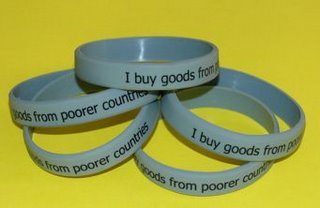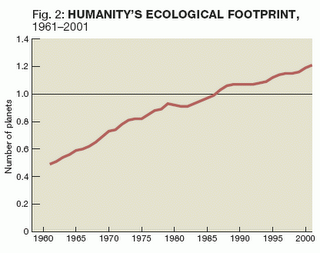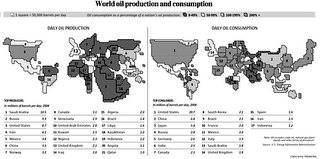The Moral Case for Globalization
 There is lots of debate on the impact of globalization on the US and on poorer countries. Here I lay out the moral case for globalization and why it is good for the world.
There is lots of debate on the impact of globalization on the US and on poorer countries. Here I lay out the moral case for globalization and why it is good for the world.
By globalization I am taking about increased trade between nations. In particular I am focusing on jobs that are created in 3rd world countries to create goods for the first world. This covers the most talked about aspect of globalization: outsourcing to India and manufacturing in China.
I am excluding the trade of natural resources in this topic. Natural resource wealth such as oil or minerals can lead to the resource curse of corruption, competitive rent-seeking, and exchange-rate appreciation crowding out other economic activity. Natural resources can cause these problems even when they aren't traded between nations. So, I don't see this as a problem caused by globalization but globalization does exacerbate it.
Lets let the maestro Greenspan define globalization and give the key moral argument for it:Globalization as generally understood involves the increasing interaction of the world's peoples through their national economic systems.
Indeed, probably the single most effective action that the industrial countries could implement to alleviate the terrible problem of poverty in many developing countries would be to open, unilaterally, markets to imports from those countries.
I have 3 main points why globalization is good.
1) Globalization leads to faster economic development in poor countries helping to bring them out of poverty
From an article in the Washington Post:Why is openness important? According to World Bank economists David Dollar and Aart Kraay, developing countries that have opened themselves the most to trade have outperformed all other economies. In the 1990s alone -- and this excludes the East Asian tigers -- the gross domestic product of poor but open countries rose twice as fast as that of rich nations. Thanks to the economic growth brought on by trade, millions were spared the misery of abject poverty.
The opening up of economies brings the rich countries' capital and knowledge to poor countries. China has been accused of "stealing" the intellectual property of other countries that do business there. While the fairness of this is up for debate, this is a transfer of know how from the rich countries to a poor country. Such transfers will help poor countries build stronger economies and bring more out of poverty.
Outsourcing in particular is good for poor countries as Salon explains:There is no better form of trade a developing nation can engage in than to sell services provided by an educated population. Compare it to anything else a developing nation can sell -- natural resources like oil or minerals or agribusiness, hard labor in manufacturing, for instance -- and you'd probably find that white-collar jobs would be the most sustainable and most eco-friendly of any of them.
There is also a case that can be made that trade is better than foreign aid. While both have their places, foreign aid can lead to dependency. It can lead to government officials becoming good at attracting aid money from rich countries rather than building a robust local economy which they can tax. While there should be no taxation without representation, the converse is also true that there is no representation without taxation. Accountability goes to those that pay the bills. If a country's government gets a lot of money from aid they are accountable to the donor nations rather than to their local people. Trade builds up local businesses which allows the people to be taxed which makes the government accountable to their people.
Economic growth is good beyond lowering poverty. Women's rights are stronger in industrialized countries. Women who can choose to work can support themselves and therefore have control over their lives. They can choose when and who they want to marry rather than this being determined by their parents.
Industrialization also leads to smaller families. If you look at birth rates between poor and rich countries, they are much lower in rich countries. Almost all agricultural based economies have high birth rates, while the industrialized countries like Japan and Italy have the lowest. Fewer children means that more resources can be given to them such as better education. They also are much healthier as seen by the lower infant mortality and higher life expectancy in rich countries.
As Benjamin Friedman writes in his book “The Moral Consequences of Economic Growth”:A society experiencing economic growth is likely to be happier and more successful than another that is not, even if the no-growth society has achieved a higher (but stagnant) standard of living.
Trade helps poor countries to develop faster economically which helps to bring millions out of poverty. It is likely more valuable than aid to help poor countries. Beyond lowering poverty, economic growth also leads to increased women's rights, better health and education, and more tolerance and happiness.
Growing prosperity, history suggests, makes people more tolerant, more willing to settle disputes peacefully, more inclined to favour democracy. Stagnation and economic decline are associated with intolerance, ethnic strife and dictatorship.
2) Globalization leads to the world being more interconnected
As issues become more global, we need more connections with the rest of the world. Free trade and business are a great way to create those connections. By being economically linked, the citizens of the US now have a stake in problems that occur throughout the world.
As stated in WorldChaning: Some people say that one of the biggest challenges facing us as a planet is that our problems are all global, and so their solutions must necessarily be global, but our circles of compassion -- the kinds of people who we feel are worth our empathy and help -- remain generally local and provincial.
One way to start solving this problem is to switch the Buy Local campaigns into Buy Global campaigns. While local community ties are valuable, so are global ties. Having the connections makes it easier to deal with global environmental issues like climate change, loss of species and loss of forests. Americans would be much more concerned about climate change leading to less water for African agriculture if we were importing those agricultural goods.
If the US had stronger economic ties to Rwanda or Darfur, do you think we would just idly sit by? It is much easier to ignore parts of the world that we have no trade with.
Because we are trading with China, we have a say in how they produce the products. We can have an impact on the way they produce them. Hank Paulson as the CEO of Goldman Sachs (now the Treasury Secretary) had many opportunities to speak with the leaders of China. He is an strong environmentalist and used his leverage to push the Chinese leadership on this issue. In Myanmar on the other hand, we have no trade and therefore have little say about the environmental damage that is going on there.
Because Nike produces shoes in Thailand, Americans now have a say in how workers are treated there. We can use globalization as a way to push for stronger worker rights as we believe they should be. Poorer nations are usually more corrupt. Interacting with them through trade gives us an opportunity to push for better reporting, transparency and accountability.
NPOs like Clean Clothes are able to fight for the rights of garment industry workers in the 3rd world from the 1st world because of globalization. Working conditions in Somalia are probably much worse than those of the sweat shops but because we have no trade with Somalia, no NPOs are able to fight to improve the living condition of Somalians.
A world that is more interdependent due to increased trade is also less likely to go to war. When India and Pakistan were thinking about going to war, the Indian government was protested by the high tech industry that knew that they would lose their outsourcing business to the US if India went to war. As Tom Friedman said "the cease-fire brought to you not by General Powell, but by General Electric". If India and Pakistan's economies were isolated, they could have gone to war with each other with much fewer repercussions. But, by being integrated in the world economy, going to war now had a much larger economic impact.
And there is Tom Friedman's Golden Arches law that no two countries that have a McDonalds have ever gone to war with each other. By being economically linked, the chances of going to war are greatly reduced. There is always an economic reason for going to war, and if businesses are going to lose, they will be against it. There are those that argue that America would be secure if everyone bought locally. I would argue the opposite. By having trade between countries, be being dependant and interdependent on each other for things as important as food, there is very little chance that they will go to war with each other. If the US were to go to war with China, we would risk losing all sorts of cheap goods, and China would lose all sorts of jobs. By being economically dependant on each other it makes the risk of war much less likely.
Globalization and trade leads to a more interdependent and connected world. This is valuable when dealing with global issues like climate change and loss of wilderness. It also makes the US more aware of problems throughout the world, and gives us influence to push for stronger environmental and worker protection.
3) Freedom
In general, I think we should give adults the freedom to engage in any business transactions they would like with each other. There are some exceptions to this, but the goal should be to allow for the maximum amount of freedom unless there is an overriding concern. Globalization allows people the freedom to have those business transactions with people in different countries.
Along with this, people should be allowed to immigrate to the country of their choice, as much as possible. Allow people to decide where they would like to live, and where they think their talents would best be used. In some cases this does lead to a brain drain, such as when doctors get trained in Africa and then immigrate to the US. But as stated in the Economist:“Better brain drain than brain in the drain,” was the much-quoted verdict of the
As I wrote about in the Brain Drain Myth, the brain drain is over rated as the immigrants earn more money in America and send large amounts of it back home via remittances. As the situation improves in their home country, they have skills they would never have learned at home which they can bring back and build 1st class companies. Devesh Kapur and John McHale argue in “Give Us Your Best and Brightest” that the threat of losing high skilled workers to America causes countries to invest more in education.
late Rajiv Gandhi, an Indian prime minister.
There are other issues with immigration as well such as how many people can be assimilated at a time. Also with freer trade there is less reason to immigrate as individuals are now able to do the same job in their home town and then trade the good over the border.
Globalization leads to greater freedom and this is a good thing.
Now lets take a look at 4 commonly heard points against globalization
1) It costs American workers jobs
When outsourcing to India was starting to take off, there was lots of press about it and how Americans were (supposedly) losing jobs. As Greg Mankiw explains on his blog, this is not the case.Job outsourcing increased productivity and real wages for low-skilled U.S. workers (1)
As long as productivity is increasing due to outsourcing, new jobs will be created to replace those that are lost. It is true that some Americans will lose their jobs, and that some might not be able to find a new job that was as good as the old. In general Americans will be better off.
McKinsey researchers tallied up the costs and benefits associated with outsourcing and found that for every dollar the United States sends abroad, we get back about $1.12, resulting in a net gain of $0.12.(2)
However, it also finds that offshoring has boosted labor productivity in the United States and that, partly because of this, there has been offsetting job creation elsewhere in the economy.(3)
But, even if it did cost American jobs, I would argue that from a global standpoint we are still better off. If outsourcing causes 1 job to be lost in America but creates 2 in India (as you can employ more for the same amount of money), this is a good thing. If we believe that we are all human, and use the concept of greatest good for the greatest amount of people and that we should help the least fortunate, such outsourcing leads to a better world.
As Peter Singer writes:Half the point of NAFTA was to ship American jobs to Mexico, which is bad for American labor but great for Mexicans. "Any transfer of work from the United States to Mexico can be expected to raise the income of people who are, on average, much worse off than those U.S. workers who lose their jobs," Singer writes. "Those who favor reducing poverty globally, rather than just in their own country, should see this as a good thing." Indeed, NAFTA has always struck me as a huge gift from the people of the United States to the people of Mexico, if a gift that not all Americans wished to give. Why the globalization debate does not see it this way is hard to fathom, other than that, perhaps, it is simply taboo to say anything favorable about the current trends in free-market economics.
2) Workers are exploited
Some argue that globalization exploits workers in poor countries. For many, being "exploited" is actually better than how they are currently living. In poor countries, there are people earn their livelihood by going through the garbage searching for anything of value. For them having a chance to work at a sweat shop even in bad conditions would be a step up.
Nicholas Kristof explains more:Mr. Shaanika and the other young men noted that the construction jobs were dangerous and arduous, and that they would vastly prefer steady jobs in, yes, sweatshops. Sure, sweatshop work is tedious, grueling and sometimes dangerous. But over all, sewing clothes is considerably less dangerous or arduous -- or sweaty -- than most alternatives in poor countries.
I would disagree with Kristof in that I think that NPOs should fight to make sure that owners abide by the local laws and push for better worker conditions. As I argued above, globalization gives NPOs more leverage to help the workers.
Well-meaning American university students regularly campaign against sweatshops. But instead, anyone who cares about fighting poverty should campaign in favor of sweatshops, demanding that companies set up factories in Africa. If Africa could establish a clothing export industry, that would fight poverty far more effectively than any foreign aid program.
So companies like Nike, itself once a target of sweatshop critics, tend not to have highly labor-intensive factories in the very poorest countries, but rather more capital-intensive factories (in which machines do more of the work) in better-off nations like Malaysia or Indonesia. And the real losers are the world's poorest people.
This raises the question of how far the companies can be pushed. From the Seattle Times:"It's good that they monitor, but not if it costs our jobs," said the Shenzhen factory worker, who has performed a variety of tasks for a Mattel contractor in the last two years, most recently stamping eyes onto plastic animals. "It's better to have bad conditions than no job at all."
It is a fine line between trying to improve the workers conditions, and pushing too hard and having the factory move somewhere else.
For a company like Mattel, it is a tricky matter figuring out what its obligation to workers — as well as to society — should be.
"Is it Mattel's responsibility to determine and pay a living wage? I don't think so," said Walter, the company's quality-assurance chief. "But should Mattel prompt a local government to determine what a reasonable wage is? We should have some impact on that."
The struggle between morality and profitability goes right to the top of the company.
"Do we want to make people's lives better? Absolutely," said Eckert, Mattel's CEO. "Do we want to unilaterally do things that make us uncompetitive and therefore our products don't sell and therefore nobody gets employed? No."
In fact, it is questionable whether paying above market wages really ends up going to workers as Kristof reports:Moreover, when Western companies do pay above-market wages, in places like Cambodia, local managers extort huge bribes in exchange for jobs. So the workers themselves don't get the benefit.
While unions and other pressures can help to improve workers wages and conditions, the greatest impact can be had by a strong economy with low unemployment. This is starting to occur in China:But as labor shortages develop, Chinese workers are starting to demand more money, adding to cost pressures from more expensive commodities and creating the classic conditions for rising export prices.
So even when exploitation occurs it is only temporary until the economy improves and everyone is better off. Going once again to Kristof:Over the past 50 years, countries like India resisted foreign exploitation, while countries that started at a similar economic level -- like Taiwan and South Korea -- accepted sweatshops as the price of development. Today there can be no doubt about which approach worked better. Taiwan and South Korea are modern countries with low rates of infant mortality and high levels of education; in contrast, every year 3.1 million Indian children die before the age of 5, mostly from diseases of poverty like diarrhea.
While the exploitation issue is real and should be fought against, many workers are better off at sweat shops then they are without it. Ultimately as the economy develops, the sweat shop phase of development will be passed through and all workers will be better off.
3) The environment is harmed
Some argue of globalization causing environmental harm due to a "race to the bottom". Companies will move to countries with the lowest environmental regulations. While this is possible, but I have seen no evidence that this is actually happening to a serious degree. There are many factors that come into play when a company is determining where to locate and environmental regulations are low on the list.
It is just as possible that there will be a "race to the top". Europe is imposing strong environmental standards on any products sold in Europe. Electronic manufacturers just want to make one version of their products to be sold everywhere in the world, so when the EU adds a restriction, it is actually added for all products globally. Certifications like FSC for sustainable logging can help to minimize the unsustainable activity on the global scale.
Globalization allows the best environmental practices to be implemented worldwide. When an engineer in Silicon Valley creates a new more efficient and economical way to make solar cells, with globalization the Chinese will be able to buy the product and benefit from this success. Likewise, if that solar panel breakthrough happened in China, I could benefit as a consumer in the US.
Another issue is that globalization uses more transportation fuel as goods have to travel a longer distance. This is true and something to be aware of. But, I think the amount of energy used to transport goods is small when compared with the amount of energy required to make them in the first place. The transportation from China to the US via barges is extremely efficient. It might actually take less fuel to travel across the ocean via a barge than it does to go from the port to your local store via a truck.
To the extent which poor countries use production techniques that are not as clean as those in the US, such as China using coal to power its industrialization, I am ambivalent. On the one hand it creates lots of environmental damage in the form of particulate matter emissions, carbon dioxide emissions, acid rain and polluting rivers. This will likely cause the premature deaths of many hundreds of thousands of Chinese. The increase in CO2 will lead to global warming impacting all people on earth.
On the other hand, higher incomes also go along with greater environmentalism. China is going through a dirty phase right now, but when incomes increase a bit more then the citizens will push for stronger environmental laws just like they have in Europe and the US. And as I mentioned before, the US can now push China for greater environmental action because we have so much trade between us.
4) It is better to buy local.
The basic premise on this is that it is better to support your neighbors and those that you can physically interact with. It builds stronger communities and deeper customer to business relationships. There is less of a chance for a company to exploit the environment or its workers because of the closer ties and the ability for everyone to see what the company is doing for themselves.
It is true that the farther away that something is, the harder it is to keep track of. Environmental degradation that is going in in China due to manufacturing plants is much easier to hide from America consumers than a plant in Detroit. There is more reporting that is going on as well as citizens that can view what is happening first hand.
But, with the internet it is now possible for reporting going on in China to be as accessible as anything that is published in the US. Transparency and reporting on companies is key not their location. Just as the internet and globalization have made it easy to manufactured products anywhere in the world, it should also be possible to monitor companies anywhere they operate in the world.
As I stated before, there are lots of benefits to greater economic integration with other countries. It gives us influence in their country and therefore gives us a right to press for better worker conditions or better environmental standards. It builds more ties between the countries and makes it easier to deal with global issues like climate change and loss of wildlife. It makes us more concerned about people throughout the world because things that affect them now affect us. And greater interdependence leads to greater peace.
Conclusion:
The impact of globalization on the world is a contentious subject. There are those that don't like it because they believe it harms the US. There are those that don't like it because they believe it exploits workers in poor countries.
I believe in general that globalization is a force for good. It brings faster economic development to poor countries, reducing poverty along with other positive changes. It makes the world more interconnected so we can solve the worlds problems and reduces the chance of war. Globalization promotes freedom.
Quick, get me one of those "I buy goods from poorer countries" wrist bands.


















